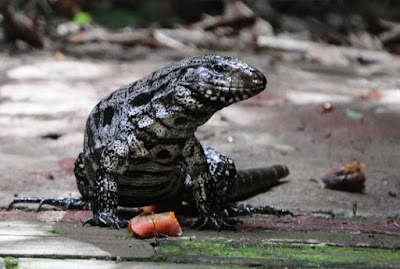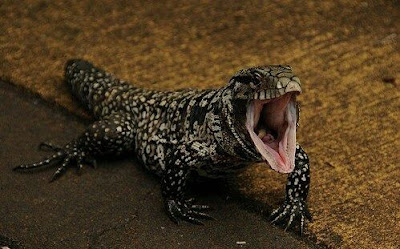The Argentine black and white tegu, also called the Argentine giant tegu,is the largest species of tegu lizard.They are an omnivorous species which inhabits the tropical rain forests, savannas, and semi-deserts of east and central South America.
Argentine tegus have unusually high intelligence. It has been observed and recorded that some will regularly and clearly seek out human affection, just as a dog or cat might. Some form a strong attachment to their keeper. Some have been reported to come on command; they can also be house-broken.
Like many other reptiles, Argentine tegus go into brumation in autumn when the temperature drops. They exhibit a high level of activity during their wakeful period of the year.
Tegus fill ecological niches similar to those of monitor lizards, and are an example of convergent evolution.
Description
As hatchlings, they have an emerald green color from the tip of their snout to midway down their neck with black markings. The emerald green becomes black several months after shedding. As young tegus, the tail is banded yellow and black; as they age, the solid yellow bands nearest the body change to areas of weak speckling. Fewer solid bands indicates an older animal. Tegus will drop a section of their tail as a distraction if attacked. The tail is also used as a weapon to swipe at an aggressor; even a half-hearted swipe can leave a bruise.
Argentine tegus are capable of running at high speeds and can run bipedally for short distances. They often use this method in territorial defense, with the mouth open and front legs held wide to look more threatening.
Adult males are much larger than the females and can reach 3 feet (92 cm) in length at maturity. They may continue to grow to lengths of 4 – 4.5 feet (120 to 140 cm).
The females are much smaller, but may grow up to 3 feet in length, from nose to tail. They have beaded skin and stripes running down their body. Adult females can reach a weight of 2.5 – 7 kg.
The skull is heavily built with a large facial process of the maxilla, single premaxilla, paired nasals, single frontal bone, and single parietal bone. Biomechanical analyses suggest the posterior processes of the parietal might be important for dealing with torsional loads due to posterior biting on one side.In the large adult animals the posterior teeth are larger and more rounded than the anterior teeth.
Diet
Tegus are omnivorous. Juvenile Argentine tegus in the wild have been observed to eat a wide range of invertebrates, including insects, spiders, and snails.They also eat fruits and seeds. As they grow they become more predatory and the protein content of their diet rises. They may seek out eggs from other reptiles and from birds' nests, and will eat small birds and other vertebrates. In adulthood Argentine tegus continue to eat insects and wild fruits, and it is assumed that such components include desirable or essential nutrients. In captivity, tegus commonly are fed high protein diets that include raw or cooked flesh such as ground turkey, canned & dry dog food, Mazuri Crocodile diet, chicken, eggs, insects, and small rodents. The inclusion of fruit in the diet is recommended. Though some captive tegus do not readily eat fruit, others really enjoy banana, grapes, mango, and papaya. However, there is evidence that, as in most husbandry of carnivores, it is good practice to cook most of the egg in the diet, so as to denature the protein avidin, that occurs in the albumen. Raw avidin immobilises biotin, so excessive feeding of raw eggs may cause fatal biotin deficiency.
As Household Pets
Argentine tegus make amenable pets, as they tend to become attached to their owners and are generally quite docile as adults. They are intelligent and can even be house-broken. A healthy tegu can live for 15 to 20 years in the wild, and possibly even longer in captivity. However, as with most reptiles, if they are not handled regularly they will show more aggressive behaviour; their bite can be painful and damaging due to strong jaws (1000N bite force, stronger than a dwarf caiman, partly due to the short deep skull) and sharp incisor teeth in the upper jaw. But most specimens will become more docile as they become larger and less fearful of their owners. Tegus do not carry venom. Tegus do have a threat display if they are upset or stressed by something. The first stage is huffing, or very heavy breathing, which means be careful. Further interference causes the animal to start lashing its tail, much like a moving snake. In wild animals there is a third stage of stamping the front feet or "dancing". If these hints are ignored then the tegu will charge and may bite, which will probably require hospital/vetinary attention depending on the victim. Any owners who take their animals outside should check the area for fox dung first, as these are the primary tegu predators, and even the calmest tegu will be alarmed at the smell to the point of possibly attacking anyone and anything within biting range.
Warm-bloodedness
Salvator merianae has recently been shown to be one of the few partially warm-blooded lizards, having a temperature up to 10 °C (18 °F) higher than the ambient temperature at night time.However, unlike true endotherms such as mammals and birds, these lizards only display temperature control during their reproductive season (September to December), and for that reason are said to possess seasonal reproductive endothermy. Because convergent evolution is one of the strongest lines of evidence for the adaptive significance of a trait, the discovery of reproductive endothermy in this lizard not only complements the long known reproductive endothermy observed in some species of pythons,but also supports the hypothesis that the initial selective benefit for endothermy in birds and mammals was reproductive.
Taxonomy
In 1839 this species of tegu was originally described as Salvator merianae. However, beginning in 1845 and continuing for 154 years, it was confused with Tupinambis teguixin, and was considered a synonym of that species. In 1995 it was again given species status as Tupinambis merianae because subsequent studies had shown that it and the gold tegu, Tupinambis teguixin, are distinct from each other. In 2012 the Argentine black and white tegu was reassigned to the resurrected genus Salvator as Salvator merianae.
S. merianae is called the "Argentine black and white tegu" to distinguish it from the "Colombian black and white tegu", which is another name for the gold tegu. Unscrupulous or incompetent pet dealers sometimes pass off gold tegus as black and white tegus.
Source: Wiki



















No comments:
Post a Comment